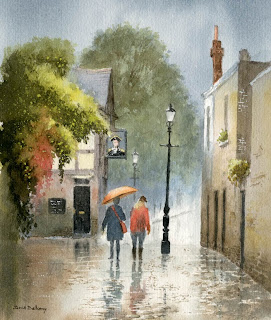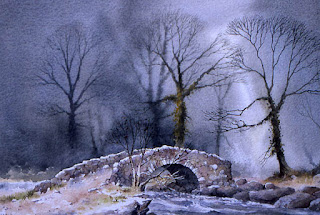With the current heatwave hitting the British Isles I reckon it’s rather nice to remind ourselves of those lovely cooling days of English drizzle. I’ve been working on sunny landscapes recently and will feature some in future blogs, but for the moment I’d like to discuss counterchange, an interesting feature that someone brought up recently.

Counterchange in a landscape scene is a very effective way of adding interest to a passage or solving a tonal problem. At its simplest it could be a change in tone across a ridge, hill, forest, mountain, or any background mass to create a tonal range running from light on one side to dark on the other, while at the same time adjusting the sky in a similar way so that the dark part of the sky stands against the light part of the hill, and vice versa. In this watercolour of a cobbled street in Hackney you can see I’ve used the method vertically on the right-hand wall just to the right of the lampost.
In this instance I’ve included it for interest rather than to solve a problem. Where the method is extremely useful in solving a tonal problem can be, for example, where you have a house with a light-coloured wall set against a dark background: if the roof is dark it will get lost in the dark background, and if it is light it will lose itself against the light wall. By laying a graduated wash over the roof, darker at the bottom and graduating to a lighter top where the roof abuts the darker background, you can thus make both top and bottom of the roof stand out, thus causing a counterchange effect using the graduated wash. One of the most simple examples of counterchange can often be found on telegraph poles or winter tree-trunks where they show up light against dark vegetation at the bottom, and dark against the bright sky at the top, depending on the light of course.
This particular painting is featured in my Skies, Light & Atmosphere book available on my website with a special offer package of book and DVD, available only from the site or my demonstrations. Don’t forget to watch out for these effects in the natural landscape when you are out and about. You can learn a lot even without your painting or sketching gear!

 I enjoy working on hot pressed paper, although it can be a little more challenging for the inexperienced watercolourist because it dries so much more rapidly than a NOT or rough paper. The advantages of using a hot pressed surface are that you can achieve really sharp, crisp edges, and it lends itself to detail. Colours can also appear more vibrant. The biggest dangers caused by the quicker drying is the possibility that you may find runbacks forming and messy brushmarks can look unsightly if not enough water is used with your colour application and washes.
I enjoy working on hot pressed paper, although it can be a little more challenging for the inexperienced watercolourist because it dries so much more rapidly than a NOT or rough paper. The advantages of using a hot pressed surface are that you can achieve really sharp, crisp edges, and it lends itself to detail. Colours can also appear more vibrant. The biggest dangers caused by the quicker drying is the possibility that you may find runbacks forming and messy brushmarks can look unsightly if not enough water is used with your colour application and washes.

 This watercolour of Hisley Bridge on the edge of Dartmoor illustrates the effectiveness of painting masking fluid over the bridge before doing any painting, then applying very fluid washes wet-into-wet for the background, bringing the wash down over the bridge with impunity, as you can lift off the masking fluid once it has dried and hey presto! the bridge appears again. The sense of mood has been accentuated by limiting the background colours in the wet-into-wet wash, with warmer colours being applied in the bridge and foreground.
This watercolour of Hisley Bridge on the edge of Dartmoor illustrates the effectiveness of painting masking fluid over the bridge before doing any painting, then applying very fluid washes wet-into-wet for the background, bringing the wash down over the bridge with impunity, as you can lift off the masking fluid once it has dried and hey presto! the bridge appears again. The sense of mood has been accentuated by limiting the background colours in the wet-into-wet wash, with warmer colours being applied in the bridge and foreground.